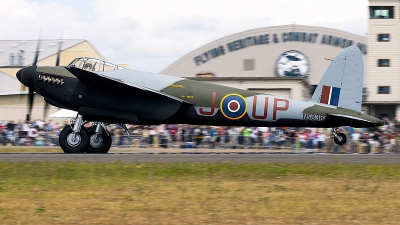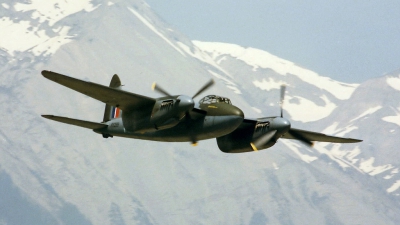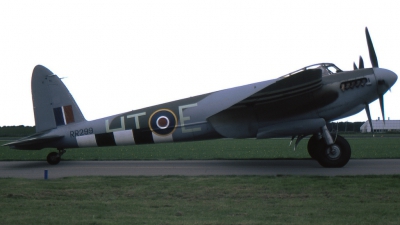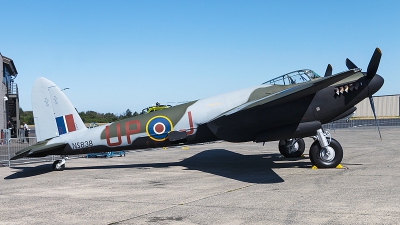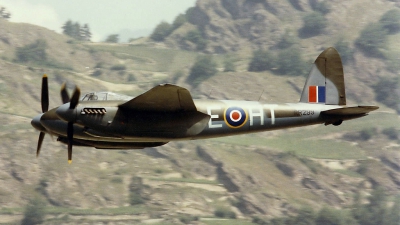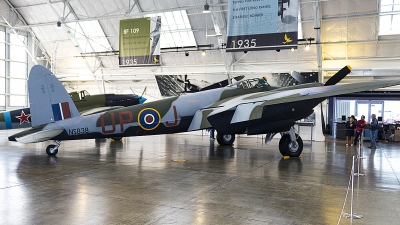Comments:  [0]
[0]
No comments yet.
You must be logged in to post a comment.
De Havilland DH-98 Mosquito T.III Aircraft Data
To ease the conversion from other twin-engined types to the high-speed Mosquito, a dual-control trainer version was proposed. On 30 January 1942 the prototype T.III, (former F.II prototype) W4053, made her first flight. The other F.II prototype. W4073, was also fitted with dual controls, as were four other early production F.IIs: W4075, W4077, W4079 and W4081. An initial production batch of 91 aircraft (serials HJ851-HJ899 and HJ958-HJ999) was built at Leavesden.
The T.III featured a 'solid' nose and although there was provision for the four 0.303in (7.7mm) Browning machine guns as in the F/NF.II, the T.III was commonly unarmed. Two underwing hardpoints allowed the use of external fuel tanks as well as a carrier for practice bombs. Another feature of the trainer was the flat fighter style windscreen. Without the weight and associated drag of weaponry, the T.III was able to reach a speed of 384 mph (618 kmh). In all 358 T.III aircraft were produced.
Engines for the Mosquito T.III were either the Rolls Royce Merlin 21 or the Merlin 23. The Merlin 21 (1,460 hp / 1,074 kW) was a Merlin XX with reversed coolant flow due to the Mosquito's wing radiator. The Merlin 23 (1,435 hp / 1,070 kW) was an adapted Merlin 22.
Overseas production of the Mosquito training version took place at De Havilland Canada at Downsview (Toronto) and in Australia by De Havilland Australia at Bankstown near Sydney.
Canadian production comprised three versions: Mosquito T.22 (based on the Canadian-built FB.21 fighter bomber) with the Packard Merlin 33 engine. Of this version six aircraft were built.
The Mosquito T.27 was the dual-control (and unarmed) version of the FB.26, with Packard Merlin 225, of which 49 aircraft were built.
The last Canadian trainer version was the Mosquito T.29. These aircraft, of which 39 were built, were powered by Merlin 225s.
Australian dual-control Mosquitos were designated T.43. This version was based on the FB.40 fighter bomber. In total 22 aircraft, originally ordered as FB.40, were completed as T.43s.
The T.III featured a 'solid' nose and although there was provision for the four 0.303in (7.7mm) Browning machine guns as in the F/NF.II, the T.III was commonly unarmed. Two underwing hardpoints allowed the use of external fuel tanks as well as a carrier for practice bombs. Another feature of the trainer was the flat fighter style windscreen. Without the weight and associated drag of weaponry, the T.III was able to reach a speed of 384 mph (618 kmh). In all 358 T.III aircraft were produced.
Engines for the Mosquito T.III were either the Rolls Royce Merlin 21 or the Merlin 23. The Merlin 21 (1,460 hp / 1,074 kW) was a Merlin XX with reversed coolant flow due to the Mosquito's wing radiator. The Merlin 23 (1,435 hp / 1,070 kW) was an adapted Merlin 22.
Overseas production of the Mosquito training version took place at De Havilland Canada at Downsview (Toronto) and in Australia by De Havilland Australia at Bankstown near Sydney.
Canadian production comprised three versions: Mosquito T.22 (based on the Canadian-built FB.21 fighter bomber) with the Packard Merlin 33 engine. Of this version six aircraft were built.
The Mosquito T.27 was the dual-control (and unarmed) version of the FB.26, with Packard Merlin 225, of which 49 aircraft were built.
The last Canadian trainer version was the Mosquito T.29. These aircraft, of which 39 were built, were powered by Merlin 225s.
Australian dual-control Mosquitos were designated T.43. This version was based on the FB.40 fighter bomber. In total 22 aircraft, originally ordered as FB.40, were completed as T.43s.
- Country of Origin: United Kingdom
- First Flight: 30 January 1942
- Initial Service Date: 1943
- No. Built: 358
- No. In Service: 0
- No. of Hardpoints: 2
- Crew: 2
Power:
Two Rolls Royce Merlin 21 at 1,460 hp
Weapons:
Provision for the installation of four 0.303in (7.7mm) Browning machine guns as in the F/NF.II.
Two underwing hardpoints allowed the use of practice bomb carrier but alternatively external fuel tanks could be carried.
Note that the Australian-built T.43 version was capable to carry the full complement of the FB.40 fighter bomber weaponry in the bomb bay as well as the four 0.303in (7.7mm) Browning machine guns in the nose and the four 20mm cannon in the forward weapons bay.
Two underwing hardpoints allowed the use of practice bomb carrier but alternatively external fuel tanks could be carried.
Note that the Australian-built T.43 version was capable to carry the full complement of the FB.40 fighter bomber weaponry in the bomb bay as well as the four 0.303in (7.7mm) Browning machine guns in the nose and the four 20mm cannon in the forward weapons bay.
Dimensions:
| Length: | 40ft 6 in. |
| Wing Span: | 54ft 2 in. |
| Wing Area: | 454 sq.ft |
| Height: | 12ft 6 in. |
| Empty Weight: | 13,104 lbs |
| Max. Weight: | 16,883 lbs |
Performance:
| Max. Speed: | 384 mph |
| Cruise Speed: | 260 mph |
| Service Ceiling: | 37,500 ft. |
| Max. Range: | 1,355 nm |
Operators:
AustraliaThe RAAF operated fourteen UK-built T.IIIs. These aircraft received serials A52-1002 to A52-1015. Pending Australian production, the first eight T.IIIs were shipped without engines to Australia near the end of 1943. Upon arrival at Bankstown they were fitted with Packard Merlin 31 or 33s.
Belgium
In 1947/1948 the Royal Belgian Air Force took delivery of seven T.IIIs: VR333, 335, 338, 339, 341, 342 and 343.
Canada
Twenty-four aircraft went to Canada for the RCAF.
Czechoslovakia
This country received two T.III aircraft in early 1948: VR347 and 348.
France
The Armée de l'Air obtained three T.IIIs on 16 August 1946: TV978, 980 and TW118, to be followed by another 10 ex-RAF aircraft in 1947 (VR330, 331, 334, 336, 340); in 1948 (VR344 an 349), with the last aircraft arriving in 1949 (VA884, 885 and VP353).
Israel
The air force received at least two ex-Armée de l'Air (France) Mosquito T.IIIs. No further details are known.
New Zealand
The RNZAF took delivery of four ex-RAAF T.IIIs (RAAF serials A52-1003, 1005, 1006 and 1015). In RNZAF these were reserialled as NZ2304, 2303, 2302 and 2301 respectively.
The RNZAF also received four ex-RAAF T.43s.
Norway
The RNoAF operated three ex-RAF Mosquito T.IIIs: VR337, 345 and 346.
Turkey
The Turkish Air Force received 10 new Hatfield-built T.IIIs.
United Kingdom
The largest customer of the Mosquito T.III was the Royal Air Force, with around 348 aircraft entering service, the majority after the conclusion of World War II. Twenty T.IIIs were delivered to the Fleet Air Arm for training of Sea Mosquito aircrew.
Yugoslavia
The country bought six T.IIIs for its air arm.
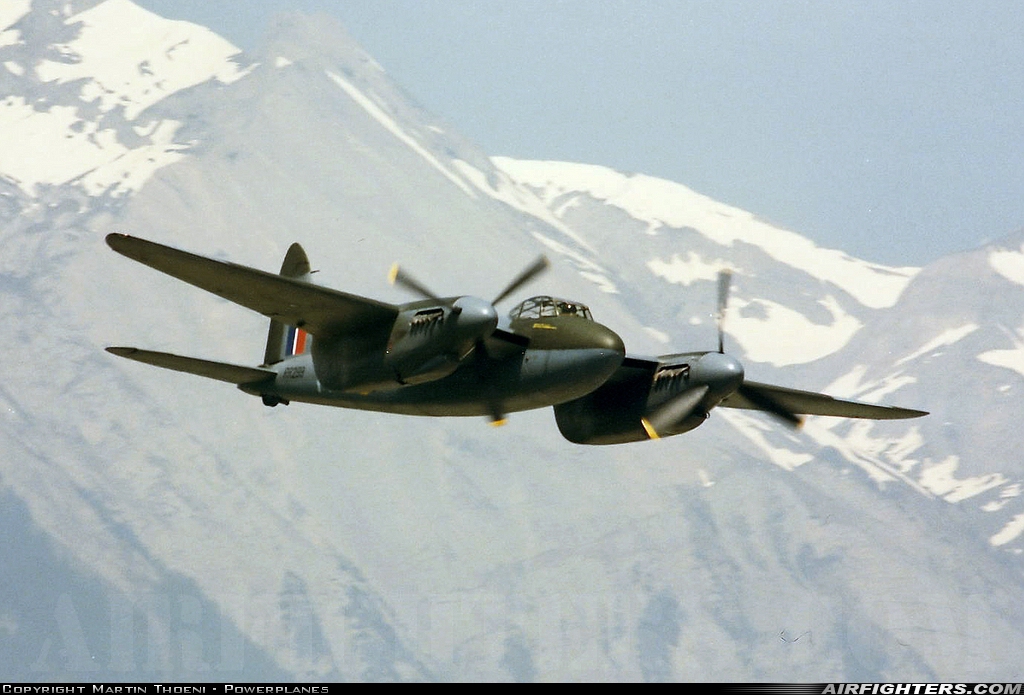
 Random great photos of the De Havilland DH-98 Mosquito T.III:
Random great photos of the De Havilland DH-98 Mosquito T.III:
